- Quick Read
- Deep Read ( 9 Min. )

Why is Christian Science in our name?
Our name is about honesty. The Monitor is owned by The Christian Science Church, and we’ve always been transparent about that.
The Church publishes the Monitor because it sees good journalism as vital to progress in the world. Since 1908, we’ve aimed “to injure no man, but to bless all mankind,” as our founder, Mary Baker Eddy, put it.
Here, you’ll find award-winning journalism not driven by commercial influences – a news organization that takes seriously its mission to uplift the world by seeking solutions and finding reasons for credible hope.
Explore values journalism About usIn Today’s Issue
- Schools and an immigrant influx: What it takes to educate all children
- Today’s news briefs
- Ukraine is trying to rally new troops. Vets say weapons are more urgent.
- Only 70 people lived on Gavdos. Then migrant boats started to arrive.
- In northern Gaza, famine sets in: ‘We will eat anything’
- She’s worth $1 billion, but can Taylor Swift write poetry? We ask experts.
Monitor Daily Podcast
- Follow us:
- Apple Podcasts
- Spotify
- RSS Feed
- Download
TODAY’S INTRO
Another crisis of uncertainty
 Mark Sappenfield
Mark Sappenfield
The pandemic showed that people struggle with uncertainty. Reading our two stories today on migration, it strikes me that here is another crisis of uncertainty.
These three things are true: People under enormous stress will move to seek safety and opportunity. There is no easy way to absorb them. There is a moral demand to treat them humanely.
Politically, that adds up to uncertainty. There is no clear policy solution. Yet perhaps we can find a different kind of certainty: a conviction that we can do better, for everyone. There will be no one solution, no perfect solution. But the Monitor has spent more than 115 years (and a good chunk of today’s issue) seeking ways forward. We can be certain that more are waiting to be found.
Share this article
Link copied.

Help fund Monitor journalism for $11/ month
Already a subscriber? Login

Monitor journalism changes lives because we open that too-small box that most people think they live in. We believe news can and should expand a sense of identity and possibility beyond narrow conventional expectations.
Our work isn't possible without your support.
Schools and an immigrant influx: What it takes to educate all children
In an election year where immigration is a top issue, how are public schools managing a sharp rise in students?
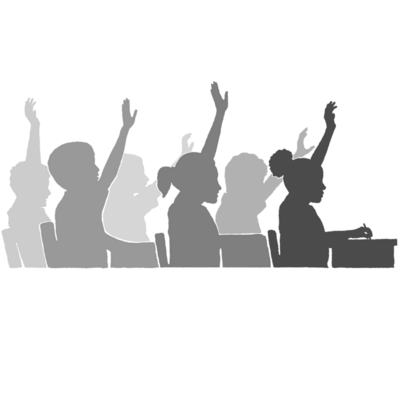
-
Jackie Valley Staff writer
In an era of historic migration globally and at home, many Americans rate immigration as a top policy issue ahead of the 2024 election. Yet like the United States itself, public schools have long welcomed foreign-born newcomers. Students in the U.S. have a right to a public education, no matter their immigration status.
Districts of all sizes across red and blue states are finding that a sudden increase of new arrivals has challenged their current capacity. An increase in newcomer student enrollment after annual funding deadlines have passed, for example, has raised questions around staffing amid existing strains. Still, many educators embrace an approach that sees these students as assets – as multilingual contributors to their communities and, one day, the economy.
That was the thrust of Education Secretary Miguel Cardona’s message last month when he visited a high school in West Springfield, Massachusetts, which is experiencing similar growth challenges and opportunities.
“We need to do more,” Secretary Cardona tells the Monitor. “The beauty is we have a lot of bilingual students in our classrooms. So how are we creating pathways for them to become the next teachers?”
Schools and an immigrant influx: What it takes to educate all children

The girl with the ponytail and overalls has four favorite sports.
“Fútbol, básquet, béisbol, y fútbol americano,” she tells her class in Spanish, seated in a circle on a rug.
A new teacher at Eagleton Elementary in Denver tells the class it will practice English tomorrow. But a cluster of kids can’t wait.
“¡Ahora!” they say, wanting to try now. New words trickle in through their ears and transform out their mouths. Fútbol becomes soccer. Béisbol turns into baseball.
This New Arrivals class, for English learners in kindergarten through third grade, is itself new. In January, soon after a migrant shelter opened nearby, the school of 212 students added another 125. Most come from Venezuela, where political and economic crises have caused millions to flee.
“When you have 17 kids in your classroom, and then the next day you have 35, you’re basically starting over,” says Janine Dillabaugh, the principal. Beyond academic support, she says, “we also have to attend to their social and emotional needs.”
In an era of historic migration globally and at home, many Americans rate immigration as a top policy issue ahead of the 2024 election. Yet like the United States itself, public schools have long welcomed foreign-born newcomers. Students in the U.S. have a right to a public education no matter their immigration status.
Districts of all sizes across red and blue states are finding that the sudden increase of new arrivals has challenged their current capacity. An increase in newcomer student enrollment after annual funding deadlines have passed, for example, has raised questions around staffing amid existing strains. Still, despite these challenges, many educators embrace an approach that sees these students as assets. They view these learners as multilingual contributors to their communities – and, one day, the economy.
That was the thrust of Education Secretary Miguel Cardona’s message last month when he visited a high school in West Springfield, Massachusetts, which is experiencing similar growth. Of the school’s roughly 130 multilingual learners, around half enrolled throughout the current school year, though the district says many have since left the area due to high housing costs.
“We need to do more,” Secretary Cardona tells the Monitor. “The beauty is we have a lot of bilingual students in our classrooms. So how are we creating pathways for them to become the next teachers?”
Back in Denver, Ms. Dillabaugh, the Eagleton principal, says she’s seen the majority of these newcomers arrive “smiling and super excited and totally willing” to jump in.
That joy is evident in the New Arrivals class, where music signals a break. Students hop around in delight, high-fiving friends. The teacher gets a high-five, too.
Beyond a “crisis” narrative
Pandemic disruptions and reporting lags in enrollment data make quantifying newcomer students difficult. Among some 49.4 million students attending public schools during the 2021-2022 school year, the most recent federal data available, roughly 1 in 10 students were English learners.
In 1982, the Supreme Court ruled in Plyler v. Doe that states can’t deny students access to public elementary or secondary schools based on immigration status. The Every Student Succeeds Act of 2015 further defined equal access to quality education for English learners.
Schools, then, become the de facto entry point into American society for many of these children. That’s why experts emphasize the need to build community among students.
“Having them feel like they belong to school is important,” says Delia Pompa, a senior fellow at the Migration Policy Institute.
Welcoming newcomers involves perception shifts, says Tania Hogan, executive director of the BUENO Center for Multicultural Education at the University of Colorado Boulder. Beyond a “crisis” narrative, she encourages schools to recognize possibilities.
Newcomers offer a “wonderful opportunity to learn a different culture, language, different perspectives,” says Dr. Hogan. For example, some students may have firsthand knowledge of rainforests or other topics taught in class.

Justin Cohea, who teaches high school in Modesto, California, sees the beauty and difficulty of serving newcomer students daily. He recently observed how defeated a student looked when her bilingual aide was out. Not a fluent Spanish speaker himself, Mr. Cohea recognized that his support alone wasn’t enough.
But he also notices the bright spots. A group of students from different cultures congregated in his classroom during lunch last year, celebrating birthdays and sharing food from their native countries.
“It was really a special time,” he says.
Funding stressors
In communities welcoming an unexpected increase of newcomer students, however, the challenge often boils down to human capital.
Are there enough teachers to staff growing schools? What about bilingual aides or educators? And does the school employ counselors or social workers who can help children acclimate, particularly after trauma they may have endured?
The Department of Education has outlined $940 million, in the president’s budget proposal for fiscal year 2025, that would support English learners. (That would be a $50 million boost from the latest fiscal year.) The federal government has also reminded states that leftover pandemic aid can support immigrant students before a funding deadline this fall.
“It’s certainly not enough,” says Ms. Pompa of the Migration Policy Institute. Most district funding, however, typically comes from local and state dollars.
Newcomer students and multilingual learners are two distinct but overlapping groups, she says. In many cases, the funding approved is merely a “political kind of compromise,” and doesn’t account for recent arrivals.
Costs appear especially concerning to conservatives. The Heritage Foundation encourages states to pass legislation that would charge tuition for unaccompanied minors, as well as students whose parents are in the country unlawfully, to attend public school. That could relieve the “financial burden” on states and districts, says Madison Marino, a Heritage senior research associate. But the constitutionality of such legislation remains unclear.
“It’s the Biden administration’s unwillingness to secure the border,” says Ms. Marino, that’s created “mounting challenges for schools across the country.”
Families make up 39% of all Border Patrol encounters along the southern U.S. border since the fiscal year began in October. Some immigrant students enter the U.S. illegally. But many arrive with their families through lawful pathways, including the Refugee Admissions Program, which is rebounding after cutbacks during the Trump administration and pandemic.
Massachusetts is among the states trying to ease the burden on school districts by sending money their way. The state offers districts around $105 per day per eligible student housed in emergency shelter, with additional grants of $1,000 per student available. Many newcomers in West Springfield Public Schools are homeless.
Born in Peru to Haitian parents, Macarena, whose last name the Monitor agreed to omit for privacy, sleeps on a couch next to her 2-year-old brother in a hotel room without a kitchen.
The second grader, who glides between English and Spanish, has several favorite parts of school: homework, spelling, tests. Plus, “I have lots of friends to speak with me” and play hide-and-seek, she says. Her favorite English word, in fact, is “friends.”

“Knowing more than one language is a superpower,” Dr. Cardona tells a class for English learners at West Springfield High School. “Raise your hand if you agree.”
They do. And when Dr. Cardona slips into Spanish, a boy in the back of the room smiles.
“Continue learning English, continue learning about one another, and continue to maintain your native language,” says Dr. Cardona, once an English learner himself. An American flag hangs behind him on the wall.
Solutions for staff and students
Getting students to that “superpower” status takes time, staffing coordination, and a little ingenuity.
The Springfield City School District in southwest Ohio has been grappling with this challenge after welcoming hundreds of children from Haiti in recent years.
The 7,400-student district employs five bilingual assistants who speak Haitian Creole and six who speak Spanish.
But bilingual assistants can’t do it alone.
District leaders have prioritized hiring educators who are credentialed to teach students who speak a different language. Even if not bilingual, they can deploy strategies to help newcomer students. Meanwhile, the district has partnered with Xavier University in Cincinnati to help existing teachers receive that credential.
“We’re just hoping that we can build the capacity in the toolboxes of our teachers that teach science and social studies and math to be as effective as they can be for the students that are sitting in their classrooms,” says Kaylin Hunsaker, coordinator of state and federal programs for the Springfield City School District.
Next year the district plans to go a step further by launching a dual-language program. Students in the kindergarten and first-grade pilot classrooms will spend part of the day learning in Spanish and the other half in English. In time, the district envisions the program expanding into other languages, Ms. Hunsaker says.
As a stopgap, some students and staff are called on to interpret in a newcomer’s native language. But advocates say that’s not a long-term solution.
“It is unfair to put that on the shoulders of another student or a school secretary or another educator,” says Keri Rodrigues, president of the National Parents Union.
At Herriman High School in Utah, senior Sebastian Panayides is one of those students stepping up – and willingly. As president of a school group called Latinos in Action, Sebastian joins fellow multilingual peers in classrooms throughout the district, where they tutor younger newcomers in English.
Originally from Venezuela, Sebastian says mastery of two languages makes him “feel way ahead of the game.” As an English learner he used to loathe language arts. Now he journals almost every day.

He models a transformation attainable to others, like fellow senior Marian Alvarez. The soft-spoken aspiring actor admits her first week at the Utah high school was difficult.
“I would come home crying because I didn’t understand anything,” says the Venezuelan student.
“Eventually I started to get the hang of it, and I’m better now,” she says in Spanish after school. While making friends has been hard, she says teachers have been kind.
“I love school”
Approaches to serving newcomers differ by school and district. But education and immigrant experts generally agree staff should strive to learn about each student’s strengths, build programs to support their needs, and engage their families. One Las Vegas model emphasizes the well-being of the entire family, not just the student.

At Global Community High School, 250 students – from countries including Cuba, Mexico, Syria, and Thailand – sit side by side in classrooms as they acclimate to the U.S.
Across the street from the high school sits another modern, sleek-looking building. It’s the Clark County School District’s Family Support Center. The one-stop shop provides assistance with school registration, community resources, legal help, medical care, and adult English classes.
“We’re giving them that trust that they’re able to come,” says Astrid Silva, director of the district’s Undocumented and Immigrant Family and Youth Success Services, which is housed within the Family Support Center.
Likewise, immigrant parents have expressed gratitude for public schools, which they see as a stabilizing force in their children’s lives.
In Denver, one grateful parent, a Venezuelan asylum-seeker, recently found an apartment to rent with friends near Eagleton Elementary.
The mother, whose name the Monitor agreed to omit for privacy, says it’s important that her daughter continues kindergarten at the school after their stay at the nearby shelter ended. On their journey north via Mexico, the woman says her daughter survived a kidnapping attempt only after the child fell sick.

Afterward, her daughter “had become a little more rebellious. But now that she’s at school, it’s stopped,” she says in Spanish. “It seems she wants to communicate, above all, in English.”
And so her daughter does, once reunited with her mom on the sidewalk after school. She’s shy but offers a few words, just above a whisper.
In English, she says, “I love school.”

Today’s news briefs
• New Iran sanctions: U.S. Treasury Secretary Janet Yellen says the United States intends to hit Iran with new sanctions over its attack on Israel.
• Boeing whistleblowers in Congress: Among those testifying are a former Boeing manager and a current engineer who has made serious safety allegations about two of Boeing’s biggest planes, the 787 Dreamliner and the 777.
• Commencement speech canceled: The University of Southern California cancels the address by its 2024 valedictorian, Asna Tabassum, a Muslim student who has expressed support for Palestinians.

Ukraine is trying to rally new troops. Vets say weapons are more urgent.
Ukraine is scrambling to bolster its defenses, and on Tuesday rolled out a new, tougher conscription law. But with resupplies still snared in Washington, some veterans warn that more troops only offer so much help.

- Quick Read
- Deep Read ( 5 Min. )
While Ukraine’s tired service members wait for military aid from the West amid increased attacks from Russia, they received some welcome news Tuesday. President Volodymyr Zelenskyy signed new measures into law to boost army ranks through a mix of conscription incentives and penalties for draft dodgers.
The new law is meant to tighten up holes in Ukraine’s draft, which all men ages 16 to 60 were required to register for after the war began. Under the new legislation, Ukrainian men risk losing their driver’s licenses or passports if they fail to keep the registry up to date.
There are also improved incentives to join up. These include 15 straight days of leave, the opportunity to choose their unit, and bonus pay and time off for destroying enemy war materiel.
But vets like Roman Kaidan, serving on the eastern front, say that soldiers aren’t what’s missing. “We can finish this war. Just give us the weapons,” he says. “It’s better to patch us up, the older experienced guys, than to send young guys to the front who are green and don’t know what to do. I would gladly save a young person’s life.”
Ukraine is trying to rally new troops. Vets say weapons are more urgent.

While Ukraine’s tired service members wait for military aid from the West amid increased attacks from Russia, they received some welcome news this week. On Tuesday, President Volodymyr Zelenskyy signed new measures into law that are intended to boost army ranks through a mix of conscription incentives and penalties for draft dodgers.
The mobilization drive could bring significant relief to assault brigades and drone squads in the combat zones of the Donetsk region. The pressure of Russian aerial guided bombs and rockets is constant here. But others stress that fighting for one’s country is a choice that must be made freely and that Ukraine’s need for weapons is far more desperate than that for fresh recruits.
“We have a shortage of people,” says Yevhen, a combat engineer from Kyiv fighting in the east. “I am not a fan of forced mobilization, but I don’t see another way. The people who stayed in civilian life don’t have the volunteer spirit, but we still need people in the army. The people who do have military spirit have already mobilized. Many have been killed or wounded. All of us are tired.”
Still, the new measures are controversial due to the pressures they put on Ukrainian society, particularly on citizens who have actively avoided the front lines.
“This is the first time that the state decides it is necessary to spread out mobilization to all citizens,” notes Ihor Kozii, a military expert for the Institute for Euro-Atlantic Сooperation who is living in Lviv. “If you look in our constitution, there is an obligation for every able man and woman to defend and protect the country. ... The big challenge now is how to restore a system of patriotic behavior to society.”
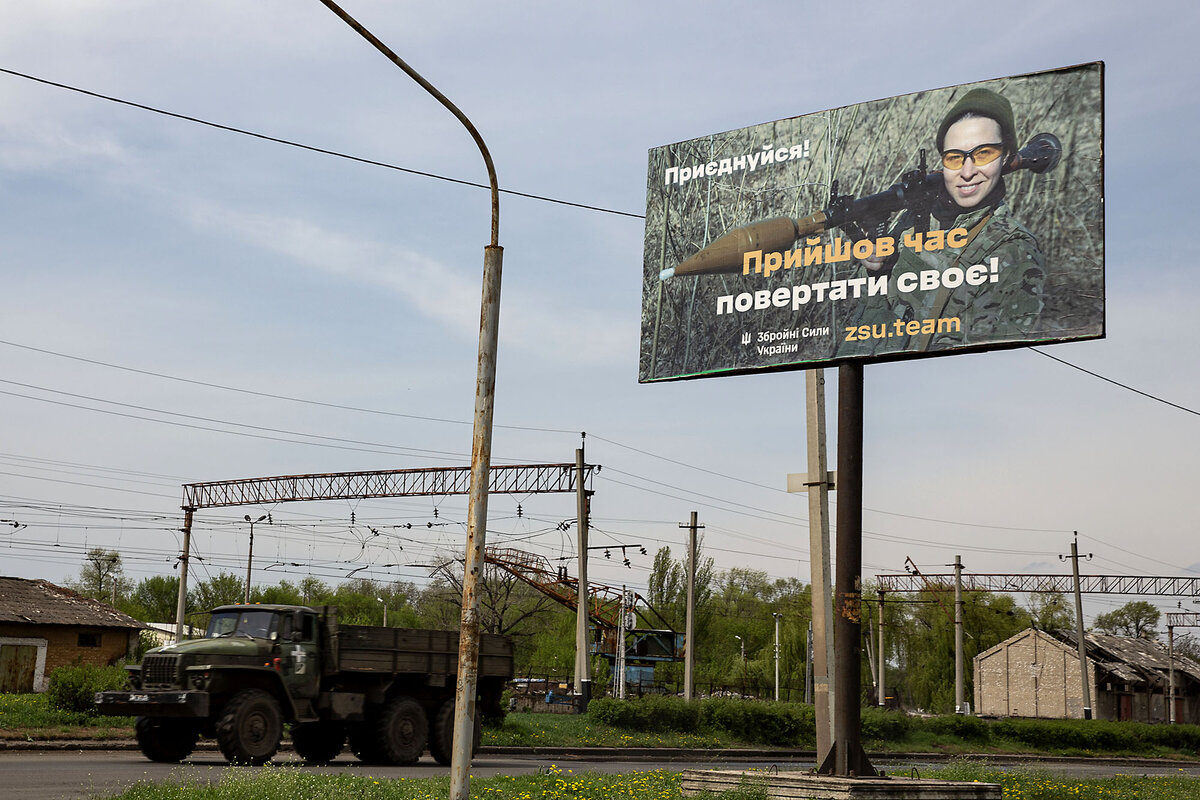
Capacity to serve
The new law is meant to tighten up holes in Ukraine’s draft, which all men ages 16 to 60 were required to register for after the war began. Under the new legislation, Ukrainian men risk losing their driver’s licenses – or their passports if they are living abroad – if they fail to keep their draft registry up to date. (The harshest and rarely enforced penalty for draft dodging, three to five years in prison, remains unchanged under the new law, however.)
There are also improved incentives to join up. These include 15 straight days of leave, the opportunity to choose which unit they join, and bonus pay and time off for destroying or capturing enemy war materiel. Families of personnel killed in action will also be entitled to a one-time payment of $380,000.
Such carrots and sticks are needed to reverse three decades of decline and downsizing by the Ukrainian armed forces, says Mr. Kozii. The army needs to mobilize 300,000 to 500,000 people, according to the assessments by the current and previous chiefs of staff.
But even that won’t be enough, due to at present a U.S. bill that would supply Ukraine with arms being held up by Congress. “Our government, our chiefs of staff, they realize that humans on the military field without weapons are nothing more than cannon meat [fodder],” he adds. “In the last two years, we had situations where we created brigades without APCs [armored personnel carriers] or without tanks. Everyone was brought together, but there were no weapons.”

“I don’t think we need large-scale mobilization,” says Roman Kaidan, in Kramatorsk taking a 10-day vacation from the eastern front. The 50-something soldier is wearing a T-shirt that says, “unlimitedly fit,” as in fit to serve.
“We can finish this war. Just give us the weapons,” he says. “It’s better to patch us up, the older experienced guys, than to send young guys to the front who are green and don’t know what to do. I would gladly save a young person’s life.”
“A question of our survival”
The new legislation also tackles how the military handles disabilities. Fake medical exemptions are one of many tactics used to dodge the draft.
“It is shameful,” says Yevhen, another soldier serving near Bakhmut. “People take pride in making up creative excuses to avoid serving in the army. This is demoralizing for all of society. ... If you don’t want to go voluntarily, it should be imposed. We live in times of war. Everyone needs to be in war mode. We will still have Russia in our backyard in 10 or 20 years. All of society needs to be useful militarily – know how to shoot and dig trenches.”
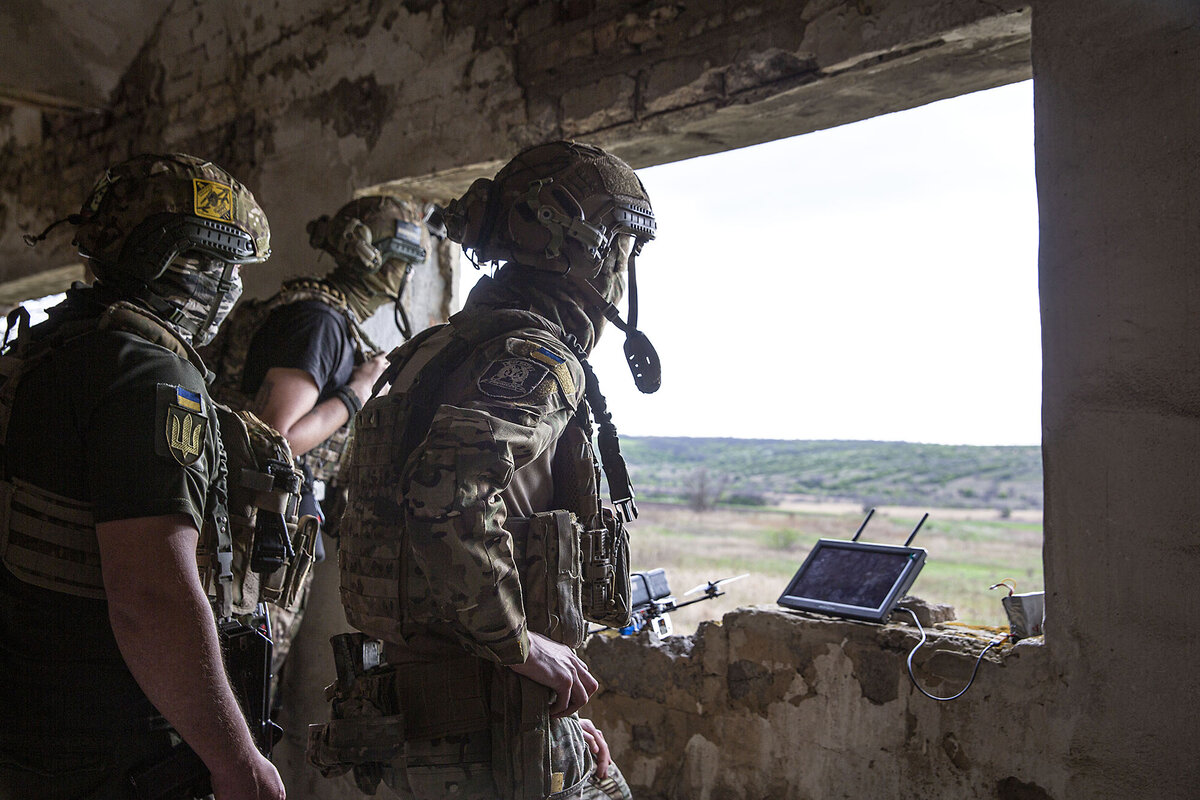
Many serving on active front lines share that view. A poll by Ukraine’s Institute of Social and Political Psychology published this month found that 43% of respondents say they are ashamed of men who evade mobilization. But an even larger share (53.9%) agreed with the statement, “Those who avoid mobilization can be understood – no one wants to die.”
Svitlana Chunikhina, deputy director of the institute that conducted the poll, is not surprised. The initial shock of Russia’s invasion galvanized people into action and overrode feelings of fear, she says. Now people see the asymmetry of power between the two armies, the delays in military aid, the failure to turn the tide of war in 2023 as hoped, and mounting casualties.
“We do realize that the most important thing that is happening in our country is happening on the front line,” says Dr. Chunikhina, who sees men grappling with the issue of serving at her private psychological practice. “It is a question of our survival. That’s why so many men in the rear live with a strong feeling of shame. But at the same time, fear is also on their minds.”
Those doing the actual fighting stress that the will and desire to serve is essential to be of any value on the front. Without it, conscripts are a burden rather than a boon – freezing in the heat of battle or suffering mental breakdowns. Others point out that there are thousands currently serving in the army who have not actually set foot in a combat zone.
“It makes no sense to have people in the army who don’t want to serve,” says Volodymyr, a member of the territorial defense unit of Kyiv now fighting around Chasiv Yar. “If a person wants to be mobilized and has the motivation to fight, he will be a good fighter. He can learn the ropes here. If the person dragged into the war is afraid and does not want to fight, that just creates risks for fellow soldiers.”
Reporting for this story was supported by Oleksandr Naselenko.

Only 70 people lived on Gavdos. Then migrant boats started to arrive.
Most migrants crossing the Mediterranean to Europe have arrived in populated areas that, even if not fully prepared, could handle newcomers. But what happens when they land someplace truly isolated?

- Quick Read
- Deep Read ( 4 Min. )
The tiny Greek island of Gavdos, which lies to the south of Crete, is home to just 70 people. But since the beginning of the year, around 1,200 migrants have arrived here by boat. In the same period last year, there were no arrivals at all.
The numbers may be modest, at least compared with the tens of thousands who arrive each year in neighboring Italy, but the impact on such a small island is huge. On one occasion recently, islanders were outnumbered by the 91 migrants who arrived on a single boat from the Libyan coast.
Most of the arrivals are economic migrants from Egypt. They are fleeing poverty and political tensions.
Gavdos has no reception center, no soup kitchen, no nongovernmental organizations. Islanders do what they can to care for the migrants, and many feel empathy for them.
“It’s a crisis,” says Lefteris Lougiakis, the deputy mayor. “We have the responsibility of providing them with shelter and food. During the winter, we cut wood to keep them warm. It’s a very difficult situation.”
Only 70 people lived on Gavdos. Then migrant boats started to arrive.
A tawny smudge on the blue horizon of the Mediterranean, it is the southernmost point of Europe, a sun-baked outpost of deserted beaches, gnarled juniper trees, and flocks of shaggy goats.
The tiny Greek island of Gavdos, which lies to the south of Crete, has until now been distinguished as the place where Odysseus was shipwrecked and held captive by the nymph Calypso, and as a destination for sun-seekers during the summer holidays.
Now, however, the island finds itself thrust to the forefront of Europe’s migration crisis, which erupted in 2015 when more than 1 million asylum-seekers reached the Continent.
Since the beginning of the year, around 1,200 migrants have arrived on Gavdos by boat, with most of them setting out from Tobruk on the coast of Libya. In the same period last year, there were no arrivals at all.
The numbers may be modest, at least compared with the tens of thousands who arrive each year in neighboring Italy, but the impact on such a small island is huge. The population of Gavdos is just 70 – on one occasion recently, islanders were outnumbered by the 91 migrants who arrived on a single boat from the Libyan coast.
Most of the arrivals are economic migrants from Egypt. They are fleeing poverty and political tensions. There is a smattering of other nationalities, including Pakistanis, Bangladeshis, Syrians, and Sudanese.
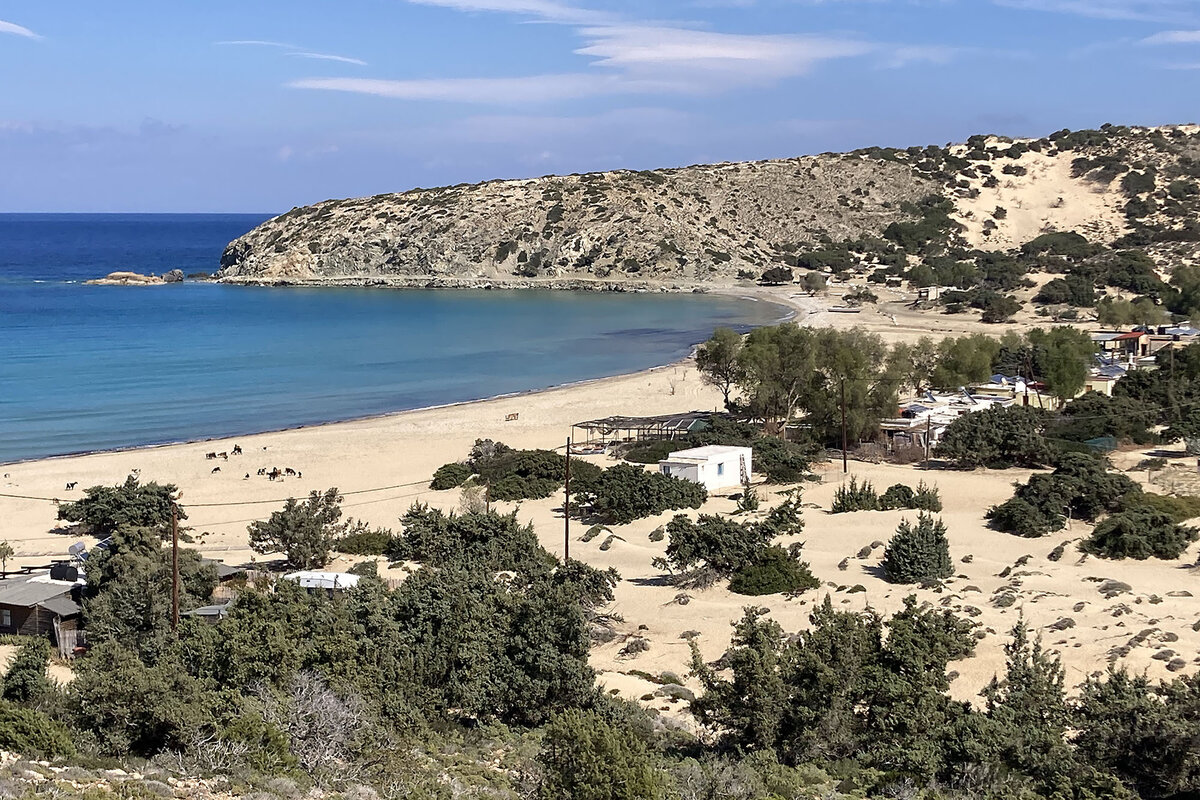
It is an influx that Gavdos is totally unprepared for. There are no facilities for the migrants – no reception center, no soup kitchen, no nongovernmental organizations. Unlike Greek islands in the Aegean such as Lesbos and Samos, which have been dealing with migrant arrivals from nearby Turkey for years, there are no personnel from charities such as the Red Cross or Doctors Without Borders.
“A very small island with very few people”
The task of dealing with the migrants is left to just three men – the deputy mayor, his twin brother, and the island’s sole police officer.
“It’s a crisis. Gavdos is a very small island with very few people,” says Lefteris Lougiakis, the deputy mayor. “We have the responsibility of providing them with shelter and food. During the winter, we cut wood to keep them warm. It’s a very difficult situation.”

Islanders do what they can to care for the migrants and many feel empathy for them.
“They travel for 20 hours in very small boats with no life jackets. It’s just by luck that we are not in their position. I feel sorry for them,” says Stella Stefanaki, who runs a small bakery on the island. She provides sandwiches for the new arrivals, for which she is reimbursed by the council.
Islanders may be sympathetic, but they want the migrant arrivals to stop as soon as possible, especially as the summer tourist season approaches.
“People are worried,” says Yorgos Lougiakis, the brother of the deputy mayor. “If tourists hear about the migrants, they will be scared to come to Gavdos.”
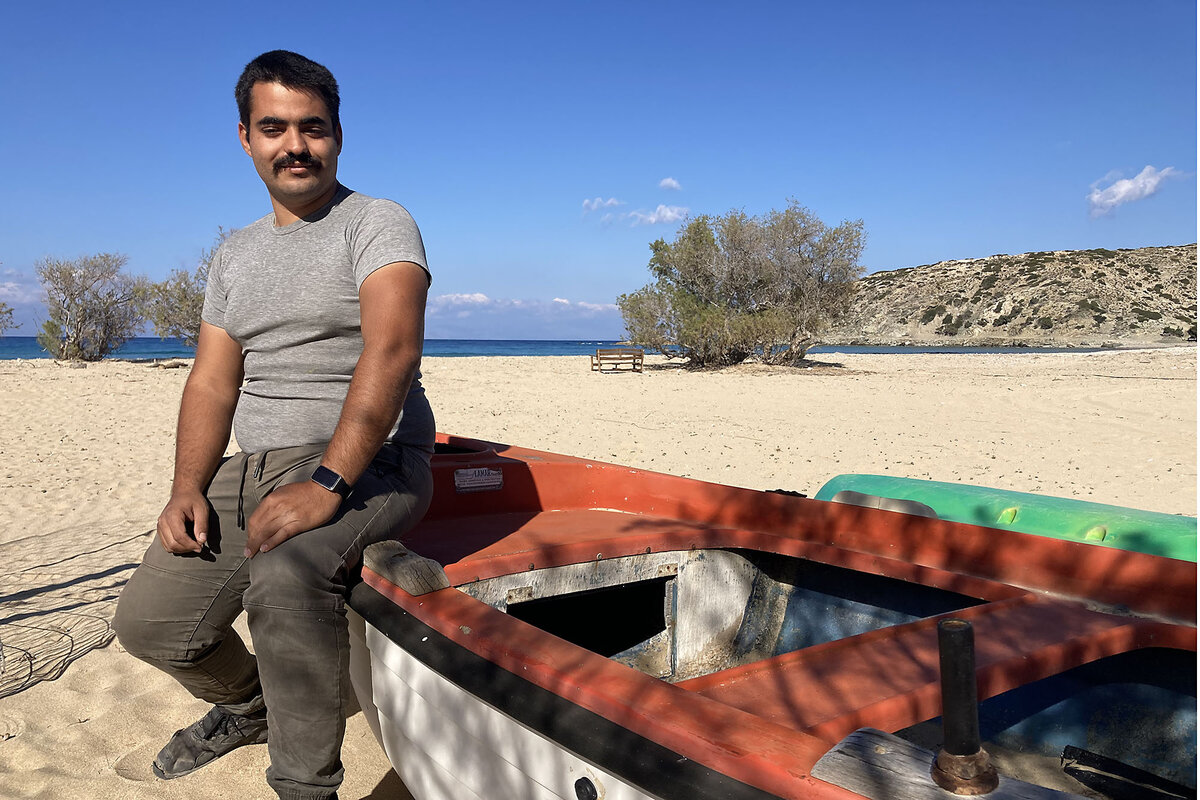
The migrants have to cross 170 nautical miles of open sea to reach the island from North Africa. It is highly dangerous, but that has not stopped smugglers from promoting it as an effective way of getting into Europe by the back door. Each migrant pays up to $5,000 for the crossing.
The inhabitants of Gavdos, which covers barely 11 square miles, fear their unique way of life is under threat.
The “capital” of the island is the village of Kastri, a cluster of about a dozen houses on a ridge. The other main settlement, Sarakiniko, consists of a few cottages and tavernas hidden among sand dunes and facing a huge sweep of beach.
There are just four children living on the island. Three of them belong to Efi Georgaka, who sells honey; keeps sheep, pigs, and goats; and, during the summer, works in the ferry ticket office in the island’s minuscule harbor.
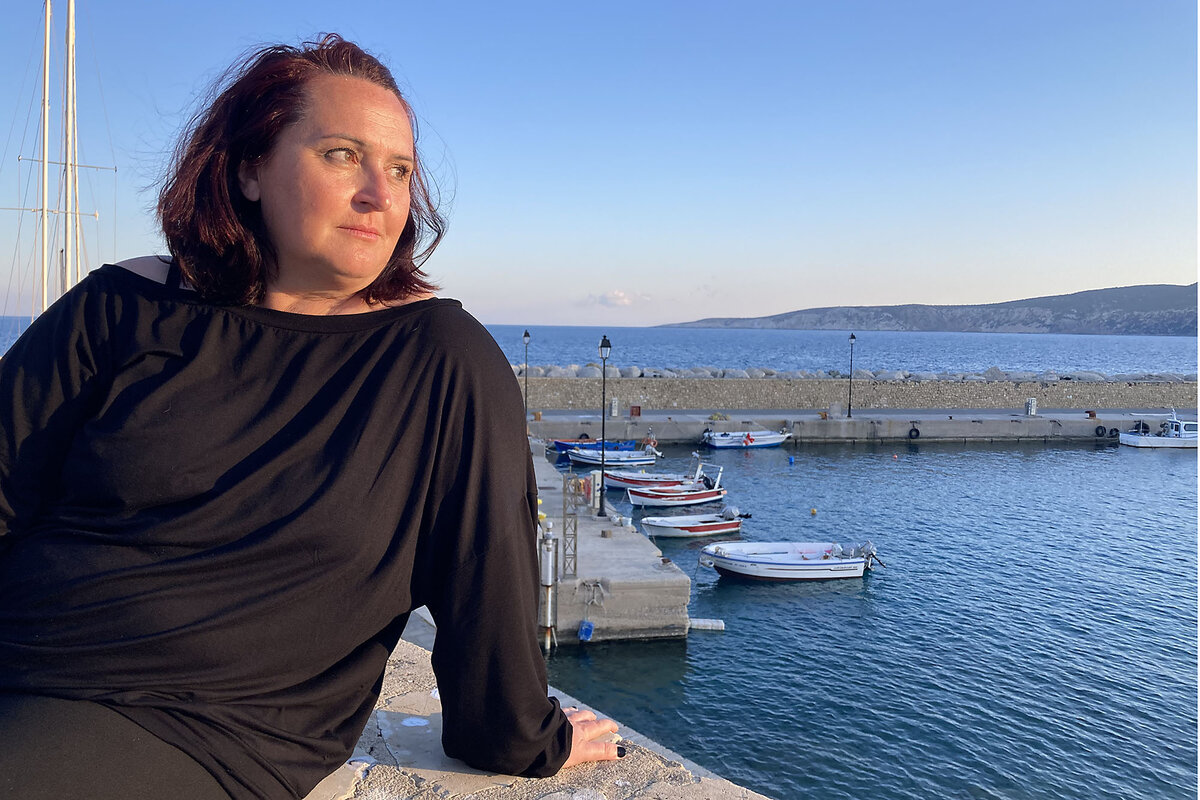
“If things keep going like this then the island will change,” she says, sitting on the harbor wall. “There will be a need for police and coast guard officers and the navy, like on other Greek islands. We don’t want them [the authorities] here. We treasure the freedom and tranquillity that we have,” says Ms. Georgaka, who has lived on the island for 16 years.
Help on the way?
Gavdos has emerged as a new migrant destination because of pressures elsewhere: a crackdown on migrant boats by Greek authorities and the EU border agency Frontex in the Aegean, twinned with the hard-line policies pursued in Italy by Prime Minister Giorgia Meloni, who has staked much political capital on stopping the boats coming from North Africa.
Earlier this month, Greece’s government promised to provide money and personnel to help Gavdos and its much larger neighbor, Crete, deal with the dramatic rise in migrant arrivals.
“Crete will not be left alone, and even more so Gavdos,” said Dimitris Kairidis, the migration minister, after paying a visit to both islands. “We are here to help the local community. The resources and the means are there.”
For the people of Gavdos, help cannot come quickly enough. The approaching summer months will bring warmer weather and calmer seas, which could encourage more migrant crossings from Libya.
“It is easy for them to come here because out at sea there is no navy, no coast guard, no Frontex to stop them,” says Mr. Lougiakis, the deputy mayor. “We hear that there are thousands of migrants in Libya, waiting to cross. I think there will be many more boats this summer. People on the island are worried that we are going to be overrun.”

In northern Gaza, famine sets in: ‘We will eat anything’
Reports indicate that the amount of flour entering Gaza may be ticking up slightly, but the need is urgent. Palestinian families are becoming increasingly desperate.

- Quick Read
- Deep Read ( 5 Min. )
-
By Ghada Abdulfattah Special contributor
-
Taylor Luck Special correspondent
When Ahmed Sawafiri isn’t chasing after parachuted aid packages, the photojournalist and father of seven from western Gaza City scours the land for grass and wild herbs.
“We have tried everything for food: animal feed, barley, leaves,” he says. “We eat for survival. We will eat anything.”
Under pressure, Israel says it is allowing mass food aid into besieged Gaza via new land and sea routes. But Palestinians in Gaza and aid workers say little has improved on the ground. And as famine sets in, families struggle to eat more than one meal a day.
With hurdles ranging from logistical issues to a lack of safety to restrictions imposed by Israel, the promised wave of food aid has been little more than a trickle, aid workers say. That leaves Gazans struggling to stave off malnourishment and starvation.
In Rafah, Sabreen Shamalakh and her six children have one meal per day despite living in an evacuee center near the hubs of humanitarian organizations in Gaza. Unable to purchase eggs, they rely on canned fava beans for their meal.
“Nutritious food is a luxury,” she says. “When the doctor at the field hospital asked me to feed my children vegetables, I told him, ‘You have to be kidding me. Where can I find them?’”
In northern Gaza, famine sets in: ‘We will eat anything’
Searching the sky, or in the fields, even on the streets, residents of the northern Gaza Strip are constantly looking for food – and finding little.
When Ahmed Sawafiri isn’t chasing after parachuted aid packages, the photojournalist and father of seven from the war-torn neighborhood of Tal Hawa in western Gaza City scours the land for grass and wild herbs.
“We have tried everything for food: animal feed, barley, leaves,” he says. “We eat for survival. We will eat anything.”
Under pressure after the deadly strike on World Central Kitchen staff, Israel says it is allowing mass food aid into besieged Gaza via new land and sea routes. But two weeks later, Palestinians in Gaza and aid workers say little has improved on the ground.
As famine sets in, families in northern Gaza, where some 300,000 Palestinians remain, and elsewhere in the strip struggle to eat more than one meal a day.
Hurdles range from logistical issues to a lack of safety to restrictions imposed by Israel. That means the promised wave of food aid has been little more than a trickle, aid workers say, leaving Gazans struggling to stave off malnourishment and starvation.
As of last week, Israel has begun operating a new crossing into northern Gaza, and is allowing hundreds of aid trucks to enter from Jordan through Israel to Kerem Shalom in the south.
Israel said eight trucks of flour from the World Food Programme entered southern Gaza Thursday in the first delivery of humanitarian aid to pass through the port of Ashdod since the war began. U.N. officials hailed the opening of Ashdod Port as a “potential game-changer” if sustained aid items widen beyond flour and canned goods.
Bottlenecks, restrictions
Despite an uptick in aid, only a handful of trucks are entering the new northern Gaza crossing daily, and bottlenecks snarl aid trucks entering Rafah.
While Israel said as many as 400 trucks were transferred to Gaza daily for multiple days last week, the United Nations says around half of those entered Gaza.

Aid officials cite logistical challenges created by Israel’s strict security procedure requiring sorting, offloading, and reloading of aid – a time-consuming process that severely reduces the number of trucks entering Gaza daily to well below what is permitted.
Another issue, U.N. officials say, is damaged roads in northern and central Gaza that affect teams’ ability to pick up and distribute aid.
Crucially, averting famine requires Israel permitting more types of food aid and restoring the strip’s damaged water, health, and sanitation systems, they say.
“Children in hospital today suffering from acute malnutrition will not be saved by pita bread,” says a U.N. official not authorized to speak to the press.
Gaza has become an enclave of haves and have-nots. There are the aid-reliant, one-meal-a-day families in central and southern Gaza, while in the north, there are those foraging for leaves.
The vast majority of the 1.9 million Palestinians in central and southern Gaza, some 1.7 million of whom are displaced, say they rely on humanitarian aid for their small daily meal: flour to bake bread and canned beans or ready-cooked meals provided by charity kitchens. Most have various forms of malnourishment.
In Rafah, Sabreen Shamalakh and her six children, all suffering from hepatitis, have one meal per day despite living in an evacuee center near the hubs of humanitarian organizations in Gaza. Unable to purchase eggs, they rely on canned fava beans for their meal.
“Food is hard to get here; nutritious food is a luxury,” she says. “When the doctor at the field hospital asked me to feed my children vegetables, I told him, ‘You have to be kidding me. Where can I find them?’”
In the north, where USAID chief Samantha Power said last week that famine is underway, there has been rare good news: the reopening of a World Food Programme-supported bakery Sunday after being closed in November due to Israeli fuel restrictions.
The bakery is able to produce 600,000 loaves of bread a day.
Yet fighting between Israel and Hamas, as well as Israeli restrictions, continues to slow food. The U.N. says 40% of attempts to deliver aid to northern Gaza last week either were denied entry by Israel or turned back due to fighting.
When to eat a lone meal
In the Shujayya neighborhood of Gaza City, Osama and his family plan their daily meal of olive oil and dried thyme and bread for 3 p.m. That's just late enough to prevent returning hunger pangs from keeping them up at night, yet just early enough to prevent him, his wife, and children from fainting for lack of food.
Some days Osama, a former laborer in Israel, and his children find wild plants such as khubaizeh, or mallow leaves, and hamasis, or rumex, to supplement a soup of tomato paste, water, and a hint of basil. A local food kitchen hands out the occasional can of lentils, but it is not enough to feed his family of 13.
“We want to feed our tired and hungry children,” he says. “We have to depend on wild plants to eat.”

The occasional arrival of aid from airdrops or handouts from the U.N. brings “better” days.
One recent day, Osama received a 6-kilogram (13-pound) bag of flour and was able to buy a half-pound of thyme, and made pastries for the children.
Another day he was able to buy a bag of potatoes, fry them up, and serve potato sandwiches – one each. “No one can have seconds,” he says.
Because of poor distribution and a lack of aid staff, most of the aid in northern Gaza can only be purchased on the gray market at inflated prices. A bag of lentils has reached $26; a 2-pound bag of rice is $30; chicken is $10 a pound.
Water, too, is scarce, with tens of thousands suffering dehydration across northern Gaza. More than two dozen children have died from dehydration or malnutrition, according to Gaza’s health ministry and the World Health Organization.
Mr. Sawafiri, the photojournalist, collects rainwater from street puddles.
“When it rains, we are happy,” he says. Yet this has not protected two of his children, ages 5 and 7, from chronic dehydration.
Mr. Sawafiri's malnourished wife is unable to breastfeed their 8-month-old daughter.
“Sometimes my daughter sleeps while crying. She puts her finger in her mouth wanting food until she sleeps,” Mr. Sawafiri says.
Recently, his daughter experienced a near miss when an airstrike hit where she was picking herbs and grass. On a recent attempt to chase after parachuted food aid drops, three people running alongside Mr. Sawafiri were gunned down by an Israeli sniper, he says.
Multiple families say they rely on rancid animal feed for their meals. They pick off insects and mold from bags of barley to find handfuls of mostly decent kernels.
“The search for food north of Wadi Gaza is beyond difficult to describe,” says Mr. Sawafiri. “It feels humiliating.”

She’s worth $1 billion, but can Taylor Swift write poetry? We ask experts.
Do poems and lyrics serve the same function in art? Or are they entirely different mediums? We asked poets (and Swift fans) for their analysis of Taylor Swift’s wordsmithing.

- Quick Read
- Deep Read ( 6 Min. )
Taylor Swift occupies a position in popular culture that makes Beatlemania seem like a passing fad. Her every move is scrutinized.
The April 19 release of her new album has been shrouded in a blackout. No advance singles. Zero interviews. But Ms. Swift’s 11th LP does appear to follow a poetic theme. The album’s tagline is “All’s fair in love and poetry.” It’s being released during National Poetry Month.
Consequently, “The Tortured Poets Department” is heating up a debate that’s been simmering since before Bob Dylan won the Nobel Prize for literature in 2016: Can lyrics qualify as poetry?
Historically, poems were often performed aloud with musical accompaniment. The etymology of “lyric poetry” is the Greek word lyrikos, which means “singing to the lyre.”
“There are people out there who would argue that a pop star can’t be a poet,” says Elly McCausland, who teaches the “Literature (Taylor’s Version)” course at Ghent University in Belgium. “She’s deliberately pushing back against that and also asking us to examine our own attitudes. What is poetry? What can poetry be?”
She’s worth $1 billion, but can Taylor Swift write poetry? We ask experts.
Taylor Swift almost eclipsed the eclipse.
During the moon’s astronomical photobomb of the sun on April 8, the songwriter posted an update to Instagram. Her video reel featured a typewriter hammering out the words, “Crowd goes wild at her fingertips. Half moonshine, full eclipse.” The first tease from Ms. Swift’s new album, “The Tortured Poets Department,” wasn’t a snippet of music. It was a lyric.
The April 19 release has been shrouded in its own form of blackout. No advance singles. Zero interviews. The result? The album is as mysterious as the identity of the boy who inspired Ms. Swift’s 2008 song “Love Story.” But Ms. Swift’s 11th LP does appear to follow a poetic theme. The album’s tagline is “All’s fair in love and poetry.” It’s being released during National Poetry Month.
Ms. Swift occupies a position in popular culture that makes Beatlemania seem like a passing fad. Her every move is scrutinized.
Consequently, her album is raising the question of whether lyrics qualify as poetry. “The Tortured Poets Department” is heating up a debate that’s been simmering since Bob Dylan won the Nobel Prize for literature in 2016.
“There are people out there who would argue that a pop star can’t be a poet,” says Elly McCausland, who teaches the “Literature (Taylor’s Version)” course at Ghent University in Belgium. “She’s deliberately pushing back against that and also asking us to examine our own attitudes. What is poetry? What can poetry be? Can a woman be a chairman of a tortured poets department?”
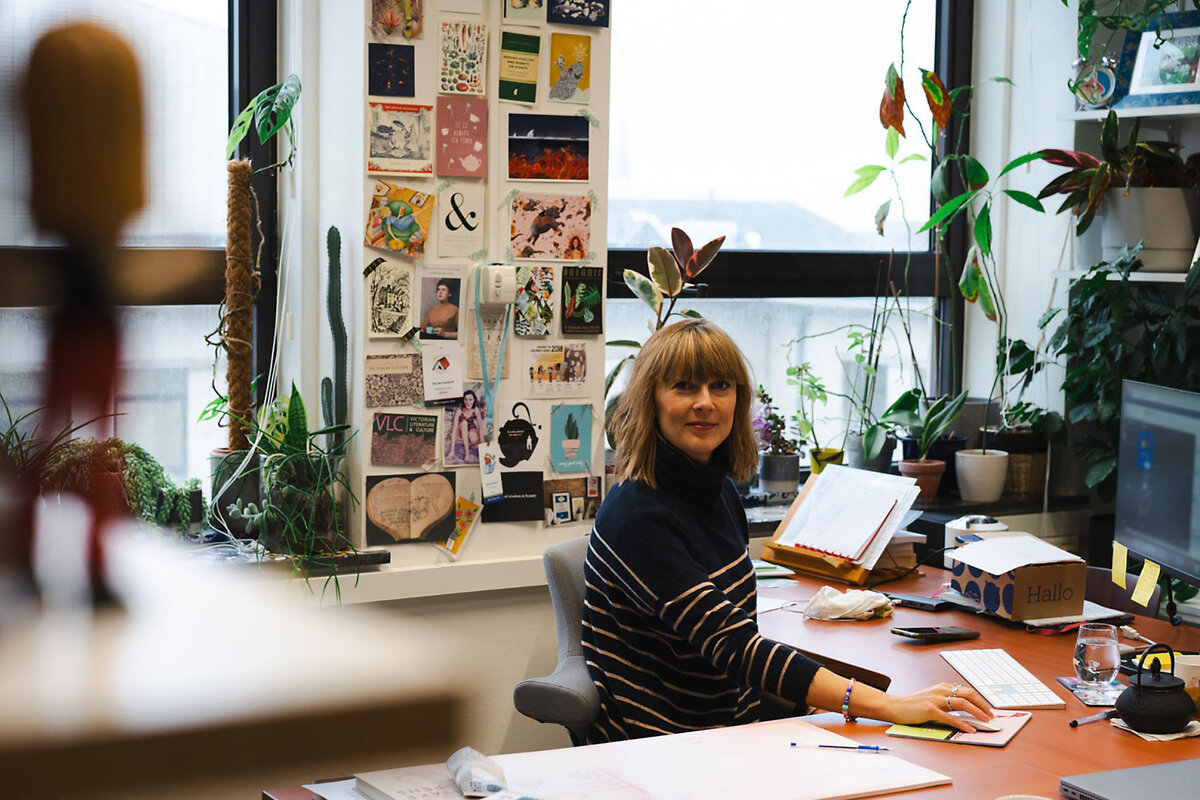
Before Ms. Swift was a songwriter, she was a poet. In fourth grade, she won a national poetry contest for her composition “Monster in My Closet.” Nowadays, she’s writing about herself as the “monster on the hill” in the hit single “Anti-Hero.” That song features couplets that showcase her wordplay: “Midnights become my afternoons / When my depression works the graveyard shift / All the people I’ve ghosted stand there in the room.”
But is it poetry?
Historically, poems were often performed aloud with musical accompaniment. The etymology of “lyric poetry” is the Greek word lyrikos, which means “singing to the lyre.”
“Gradually, they’ve drifted apart. And now I think with artists like Taylor Swift, we see them coming back together,” says Dr. McCausland, who teaches students how the songwriter fits into a genealogy of literature dating back to the 10th century.
By contrast, Publishers Weekly poetry reviews editor Maya C. Popa says although lyrics can be poetic and poems can be musical, they are different mediums.
“On the page, as a poet, without the music, you’re putting a different kind of pressure on the language to convey musicality, to convey depth, and to lean into mystery,” says Ms. Popa, a Swiftie whose latest book is titled “Wound Is the Origin of Wonder.” “[T.S.] Eliot said genuine poetry communicates before it is understood. I don’t think that’s true, necessarily, for song lyrics.”
She adds that debates over whether lyrics qualify as poetry “reveal the frivolities of the human ego … and our impulse to create hierarchies in all things.”

Ms. Swift’s connections to poetry predate her latest album. She has cited Emily Dickinson – who is her sixth cousin, three times removed – as an influence. The liner notes for “Red” name-check Nobel Prize winner Pablo Neruda. In 2017, the pop star published two poems in a mock-up magazine bundled with her “Reputation” album. But it was the 2020 album, “Folklore,” on which Ms. Swift appeared to consciously court comparison to classic bards. Its artwork features a quill-like font and photos of the singer wandering through woods in cottagecore outfits. The solitary writer communing with nature. Not a single paparazzo in sight.
“Take me to the Lakes, where all the poets went to die,” she sings on the album closer “the lakes.” Lord Byron and his fellow Romantics were rock stars of the 19th century. By contrast, female geniuses faced social censure. Emily Dickinson was deemed a “weird spinster,” says Ms. Popa. In her song, Ms. Swift asks, “Tell me what are my Wordsworth.” It raises the question: If the author of “Because I could not stop for Death / He kindly stopped for me” were alive today, would she be worth $1 billion?
“[Swift’s] really interested in thinking about, ‘Why is what I’m doing different to what Wordsworth [was] doing? And how is it the same? And what is the tension between those things?’” says Clio Doyle, author of the upcoming book, “Dear Reader: Taylor Swift and the Idea of English Literature.”
Dr. Doyle cites the 10-minute version of “All Too Well” as an example of Ms. Swift’s literary wordsmithery. The song chronicles a brief, clandestine relationship. “You kept me like a secret / But I kept you like an oath,” Ms. Swift sings.
“The ways in which she’s explaining why it was great and why it shouldn’t have ended, and why it’s such a tragedy that the guy ended it, are also kind of ways in which she’s revealing that maybe it was never great at all,” says Dr. Doyle, who teaches a course on Taylor Swift and Literature at Queen Mary University of London.
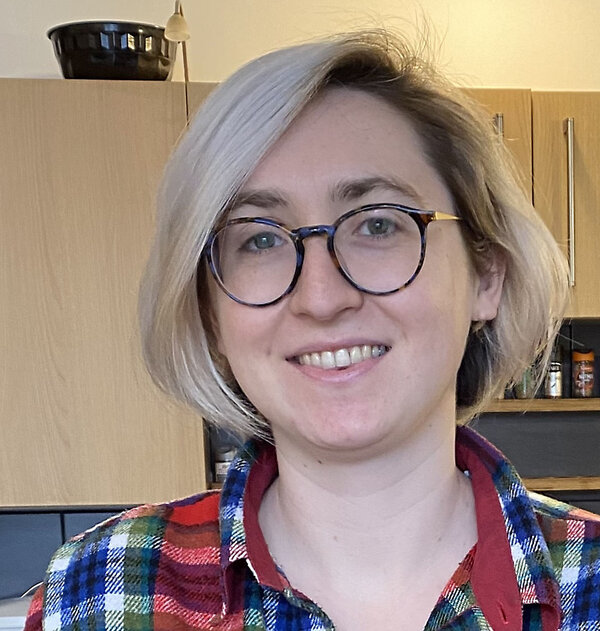
In her songs, Ms. Swift has checked into the heartbreak hotel so many times that she really should sign up for the rewards program. So it’s not entirely surprising that her social media posts are signed, “Chairman of the Tortured Poets Department.” But some of the new album’s song titles – “But Daddy I Love Him” and “I Can Fix Him (No Really I Can)” – suggest that Ms. Swift isn’t taking herself too seriously.
“She exemplifies that side of poetry – the lyricism, but also the approachability – which is where I would say that poetry is going in general,” says poet Kara Lewis, a Best of the Net nominee and an editor for On the Left Bank, a journal of socialist art and poetry.
Poetry’s new stars are so-called Instapoets, explains Ms. Lewis, who once spent 20 hours creating a light-up sign to take to Ms. Swift’s “1989” tour. Platforms such as Instagram, TikTok, Tumblr, and Substack offer an alternative to “gatekeep-y” institutions. The Instapoetry genre tends to be bite-size, with subjects ranging from social justice issues to diaristic reflections on relationships. Much like Ms. Swift’s lyrics.
“There are poems for every day and every moment of our lives because poets make the world more sensible to us, through attention and reflection,” said Ricardo Alberto Maldonado, president and executive director of the Academy of American Poets in a quote provided via email. “I’m jazzed to hear what Swift makes of poetry’s calling in her album. ... We hope she brings millions of readers across the globe to poetry.”
At Newton Free Library in Massachusetts, a “Tortured Poets Department” display features books such as “Postcolonial Love Poem” by Natalie Diaz and “Blushing” by Paul B. Janeczko. Nationwide, numerous libraries have scheduled listening parties for the new album that will also feature blackout poetry.
“I’m very pleased that people gravitate to her lyrics,” says Ms. Popa, whose gateway to poetry was listening to Rufus Wainwright’s literary songs. “I hope it inspires them to write their own lyrics, to write their own poems, and then to go in search of poets who have dedicated themselves to poetry. I think that’s the best possible scenario.”
Other headline stories we’re watching
(Get live updates throughout the day.)The Monitor's View
Replenishing Ukraine
- Quick Read
- Deep Read ( 2 Min. )
-
By the Monitor's Editorial Board
In his travels around Ukraine and abroad, President Volodymyr Zelenskyy often relies on a theme of ceaseless replenishment. His country, of course, needs more arms and money from the West. Just as critical is a need to mobilize more people into the military. On Tuesday, for example, he signed a new law aimed at recruiting or forcibly enlisting far more Ukrainians, both men and women, into an army faced off against a Russian military many times its size.
President Zelenskyy also tries to replenish a key motivator for his people to join the army and otherwise resist Russian aggression – Ukraine’s identity as an independent people with a unique culture, something Russian President Vladimir Putin claims never existed.
In a speech last month, President Zelenskyy said culture has even greater significance in war than during peace. One example is Nataliia Pidhirnia-Babin, a painter who draws images of beauty on fragments of Russian military armaments. “It reminds us that when this horrible war is over, we will still have our identity,” she said. Perhaps most importantly, she added, artists “remind people that the energy of beauty wins over the energy of death.” Such sentiments show how President Zelenskyy's continuing support and efforts are paying off.
Replenishing Ukraine

In his travels around Ukraine and abroad, President Volodymyr Zelenskyy often relies on a theme of ceaseless replenishment. His country, of course, needs more arms and money from the West. Just as critical is a need to mobilize more people into the military. On Tuesday, for example, he signed a new law aimed at recruiting or forcibly enlisting far more Ukrainians, both men and women, into an army faced off against a Russian military many times its size.
President Zelenskyy also tries to replenish a key motivator for his people to join the army and otherwise resist Russian aggression – Ukraine’s identity as an independent people with a unique culture, something Russian President Vladimir Putin claims never existed.
In just over two years, Russia has destroyed hundreds of religious buildings, music halls, libraries, art institutions, and other expressions of Ukrainian life. Yet the arts and culture scene in many parts of Ukraine is still flourishing, in part out of defiance, as well as to affirm the national identity. The invasion has accelerated “the crystallization of a modern democratic European-oriented political nation,” wrote Bohdan Nahaylo, chief editor of the Kyiv Post.
In a speech last month at a ceremony for state prizes in works of culture and art, President Zelenskyy said culture has even greater significance in war than during peace.
“Everyone who speaks out for Ukraine. Who voices what’s on their hearts. Who preserves everything we go through. Who revives what could have been forgotten but, renewed, gives people strength, gives emotions,” he said. Such people, he added, “must have hearts that do not live only for themselves.”
Art is a form of resistance, says Nataliia Pidhirnia-Babin, a painter who draws images of beauty on fragments of Russian military armaments, such as artillery shell casings. “It reminds us that when this horrible war is over, we will still have our identity,” she told the Kyiv Post. “Art is our foundation, and with it, we will remember who we are, and we will be able to move on.”
Perhaps most importantly, she added, artists “remind people that the energy of beauty wins over the energy of death.” Such sentiments show how President Zelenskyy's continuing support and efforts are paying off.

A Christian Science Perspective
Each weekday, the Monitor includes one clearly labeled religious article offering spiritual insight on contemporary issues, including the news. The publication – in its various forms – is produced for anyone who cares about the progress of the human endeavor around the world and seeks news reported with compassion, intelligence, and an essentially constructive lens. For many, that caring has religious roots. For many, it does not. The Monitor has always embraced both audiences. The Monitor is owned by a church – The First Church of Christ, Scientist, in Boston – whose founder was concerned with both the state of the world and the quality of available news.
Undisturbed amid the churn
- Quick Read
- Read or Listen ( 4 Min. )
-
By Mimi Oka
When the waters of life get turbulent, we can look to God, Spirit, for strength, peace, and safety.
Undisturbed amid the churn
A few years ago I was canoeing some rapids with a friend who is a champion kayaker. I had no experience with these water sports and was trusting my friend completely, paddling hard the way he told me to, as the canoe was tossed about. It was tempting to just let the canoe be carried along. But he insisted that we keep on paddling, otherwise the river would be in charge, and we would not be navigating the canoe.
This river was as familiar to him as the mountain roads he drove every day. He could anticipate a change in the current or hidden shallows below the surface by the light reflected on the water or the way the waves were breaking. My friend was seeing through a different lens than I was, and then translating his understanding into guidance that I could follow, which enabled us to calmly and successfully make it through.
This has been a useful lesson for everyday life, too. Sometimes when we look at the world around us, we may feel tossed about by the turbulence of war, political division, or dysfunction in our bodies or homes. How can we find a deep and settled sense of peace in the midst of this?
A shift in perspective is key. Through my study and practice of Christian Science, I’ve found that when we look to God for perspective, rather than ruminating on problems, we find comfort, strength, and healing.
Mary Baker Eddy, who founded the church that publishes this news publication, described the Bible as the “chart of life, where the buoys and healing currents of Truth are pointed out” (“Science and Health with Key to the Scriptures,” p. 24).
We too can turn to the Bible as a reliable “chart of life.” In its first chapter, which describes God’s creation, a sense of order, provision, and purpose is expressed throughout. It points to the spiritual structure supporting the unfoldment of God’s plan, and man – which includes all of us – as created in God’s image, spiritual, complete, and blessed. In truth, each of us expresses the divine qualities of our creator.
We each have the capacity to know and understand this relationship to God, which brings great blessings. But it isn’t found by looking to the material senses. God is Spirit, and therefore we discern the reality of God’s creation through spiritual sense. Spiritual sense is intrinsic to our identity as God’s children.
So if what we’re seeing or experiencing doesn’t express order, grace, and peace, we can look through the lens of Spirit for God’s view. Science and Health refers to “the translation of man and the universe back into Spirit” (p. 209). This doesn’t mean ignoring what’s going on. Rather, when things do get turbulent, we can affirm everyone’s ability to witness the presence and power of God, good, right where we are. As we do this, we see that inharmony doesn’t have legitimate standing or power over us, because it could never be part of God’s creation. Christ Jesus proved this through his many healing works.
I had a modest experience along these lines as my canoeing friend and I were coming to the end of the course. There was a sharp drop and a patch of water roiling around some rocks, and we capsized. I was caught underwater and had no idea which way was up. As the water churned all around me, I reached out to God, knowing that God is always present, guiding and protecting us.
At that moment I found that I could breathe, even though it was dark. I realized that my head was now above water and I was floating along under the overturned canoe, which had created a protective space for me. I felt at peace and tremendously grateful for the tangible sense of God’s presence despite the turbulence outside. When I popped out from under the canoe, I found my friend clutching on to the outside of the canoe. We were both completely unharmed.
The Psalmist writes, “If I ... dwell in the uttermost parts of the sea; even there shall thy hand lead me, and thy right hand shall hold me” (Psalms 139:9, 10). And Science and Health explains, “Undisturbed amid the jarring testimony of the material senses, Science, still enthroned, is unfolding to mortals the immutable, harmonious, divine Principle ...” (p. 306).
Whatever kind of turbulent waters we may see or experience, with the Bible as our “chart of life” we can find greater confidence and peace as we go forward, holding to the spiritual fact that God’s law of good is always active. And we will increasingly see that goodness, harmony, and order expressed in tangible ways.

Viewfinder
Reading, writing, and spring-cleaning

A look ahead
Thank you for joining us today. Please come back tomorrow when Ned Temko looks at the array of countries that helped protect Israel from Iranian missiles on Saturday night, including Jordan and Saudi Arabia. It was a foretaste of the sort of regional arrangement Israel might one day enjoy, if it offers an internationally acceptable resolution of the Palestinian issue.


